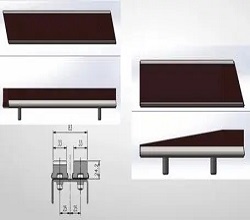𐄀 Technology Connection to Future

With the rise of electric vehicles (EVs) in recent years, there has been a growing need for efficient and reliable charging infrastructure. One innovative solution that has gained popularity in the EV industry is the use of pantographs for charging. In this blog, we will explore the various applications of pantographs in electric vehicle charging infrastructure.
Before we delve into the pantograph application in EV charging infrastructure, let's first understand what a pantograph is. A pantograph is a mechanical linkage that is commonly used in overhead wire systems, such as those found in trains and trams, to collect electric power. In the context of EV charging solution, pantographs are used to connect a vehicle to a charging station to recharge its battery.
One of the key pantograph application in EV charging infrastructure is for fast and efficient charging at public charging stations. Traditional plug-in charging can be time-consuming and inconvenient, especially for EVs with larger battery capacities. Pantographs offer a more convenient and faster charging solution, allowing EVs to quickly top up their batteries while on the go.
Another pantograph application in EV charging infrastructure is for fleet charging. Many businesses and organizations are now using EVs for their fleet operations, such as delivery services and transportation companies. Pantographs can be installed at fleet depots or charging hubs to provide a seamless and efficient charging solution for multiple vehicles at once.
Pantographs can also be used in dynamic wireless charging systems for EVs. Dynamic wireless charging systems use electromagnetic fields to transfer energy from a charging pad on the road to a receiver on the vehicle. Pantographs can be integrated into the receiver to collect the energy and charge the vehicle's battery while it is in motion. This technology is particularly useful for electric buses and trucks that have fixed routes and frequent stops.
There are several benefits to using pantographs in EV charging infrastructure. One of the main advantages is the speed and efficiency of charging. Pantographs can deliver high power levels, allowing EVs to quickly recharge their batteries in a matter of minutes. This is especially important for commercial vehicles that need to minimize downtime and maximize productivity.
Using pantographs for charging also eliminates the need for manual intervention, making the charging process more convenient and user-friendly. Drivers simply need to park their vehicle under the charging station, and the pantograph will automatically connect to the vehicle and start charging. This automated process helps streamline operations and reduce the risk of human error.
In conclusion, pantographs are a versatile and efficient solution for EV charging infrastructure. Whether it is for public charging stations, fleet charging, or dynamic wireless charging systems, pantographs offer a fast and convenient way to recharge electric vehicles. As the demand for EVs continues to grow, the use of pantographs in charging infrastructure is expected to increase, helping to create a more sustainable and environmentally friendly transportation system.